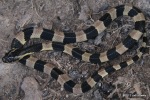Bungarus fasciatus
Venomous and Deadly!

|
|
English name: Banded Krait
Scientific name: Bungarus fasciatus
Thai name: Ngu Samlaem
Description: To 212 cm long. Triangular body with a high vertebral ridge and a short, blunt tail. Head is broad and flattened and eyes are small. Body is marked with distinct dark and light bands of equal width. Bands are usually black and yellow, but can be black and white in some individuals. Underbelly is the same color as the top of the snake. Head is black with a yellow chin/throat and a narrow yellow inverted-V on the top.
Similar Species: Common Bridle Snake has a more slender, vertically compressed body, longer tail, less distinct bands near the tail, and never has yellow bands.
Common Wolf snake does not have the triangular body shape and has less distinct bands.
Red-tailed Pipe Snake has a round rather than triangular body, much narrower light bands, and a broader tail.
Malayan Krait has a more rounded body, long tail, and narrower head.
Sea Snakes (family Hydrophiinae) and Sea Kraits (family Laticauda) have a paddle-shaped tail and are found in marine habitats.
Habitat: Found in lightly forested areas, shrubland, open plains, marshes, and agricultural land, often near human habitations. Can be found on the coast and will enter salt water. Hides under rocks and logs or in termite mounds, rodent burrows, drains, or houses during the day, waiting until dark to become active and hunt.
Place in the ecosystem: Eats other snakes, lizards, frogs, and fish. Is eaten by larger snakes and birds of prey.
Danger to humans: When disturbed, the Banded Krait will often thrash about and try to hide its head rather than biting. That doesn’t change the fact that it is one of the deadliest snakes in Thailand. Under no circumstances should you handle or harass this snake, or any other banded snake unless you have made a 100% positive identification. See “Interesting Facts” for more specifics.
Conservation status and threats: No known conservation threats in Thailand. Is listed in CITES Appendix II and is considered “Endangered” in China and Singapore.
Interesting facts: Though not quite as deadly as its notorious relative the Many-banded Krait, the Banded Krait is still one of the deadliest snakes in Thailand. Most bites happen to people who step on a krait or try to pick one up. Always be careful to watch your step when in potential snake country, and never pick up any snake unless you are 100% confident what species it is and know that species to be harmless.
Kraits have a “neurotoxic” venom that is fast-acting and primarily affects the nervous system. Initial symptoms are abdominal cramps (due to gastrointestinal hemorrhaging), nausea and disorientation, progressing to difficulty in speech, tremors, and seizures, and eventually complete paralysis. Breathing becomes more difficult as the venom takes effect and death usually results from respiratory failure. Heart failure is also possible due to the cardiotoxicity of the venom. Death can occur within 5 to 20 hours without treatment (faster if a vein is bitten), but injection of the correct antivenom will reverse the symptoms if done speedily enough. A quick trip to the nearest hospital will usually save the victim’s life. Artificial respiration may be necessary if the victim’s breathing stops before the antivenom has the chance to be administered or take full effect. Necrosis of the flesh can develop in the days following the bite if the victim survives the initial symptoms.
If you or someone you are with is bitten by a Banded Krait, the most important steps are to:
1) Keep the victim calm, having them lie down with the bite mark below the heart if possible.
2) Take a picture of the snake to confirm identification for the hospital.
3) Get the victim to a hospital immediately where professional treatment can take place and antivenom can be given.
4) Start rescue breathing if the victim’s breathing stops and continue until they are in the care of medical professionals.
References:
Wikipedia: Bungarus fasciatus
Wikipedia: Bungarus
Hong Kong University: Banded Krait
Ecology Asia: Banded Krait
Wild Singapore: Banded Krait
A Photographic Guide to Snakes and Other Reptiles of Peninsular Malaysia, Singapore and Thailand
A Field Guide to the Reptiles of South-East Asia
A Field Guide to the Snakes of South Vietnam
Snakes of Thailand and their Husbandry
Snake Bites and their Treatment
Simon and Schuster’s Guide to Reptiles and Amphibians of the World









Aren’t the snakes with black and white bands Malayan Kraits? Even deadlier and more dangerous than the banded Kraits.
That’s a good guess, but in fact Banded Kraits have a pale/white color phase too. You can tell they are Banded Kraits due to their triangular body, blunt tail, and large head. Malayan Kraits have a rounder body, longer tail, and narrower head. You can see a few of them here: https://bangkokherps.wordpress.com/snakes/malayan-krait/